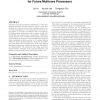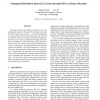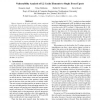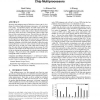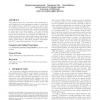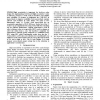128
click to vote
ACMMSP
2006
ACM
15 years 6 months ago
2006
ACM
This paper proposes and studies a distributed L2 cache management approach through page-level data to cache slice mapping in a future processor chip comprising many cores. L2 cach...
87
Voted
MICRO
2006
IEEE
15 years 6 months ago
2006
IEEE
This paper presents and studies a distributed L2 cache management approach through OS-level page allocation for future many-core processors. L2 cache management is a crucial multi...
103
Voted
ISCA
2006
IEEE
15 years 6 months ago
2006
IEEE
Long interconnects are becoming an increasingly important problem from both power and performance perspectives. This motivates designers to adopt on-chip network-based communicati...
101
click to vote
DATE
2006
IEEE
15 years 6 months ago
2006
IEEE
Memory elements are the most vulnerable system component to soft errors. Since memory elements in cache arrays consume a large fraction of the die in modern microprocessors, the p...
105
Voted
ICCD
2007
IEEE
15 years 6 months ago
2007
IEEE
Leakage power has grown significantly and is a major challenge in microprocessor design. Leakage is the dominant power component in second-level (L2) caches. This paper presents t...
95
Voted
IEEEPACT
2008
IEEE
15 years 6 months ago
2008
IEEE
Recently, chip multiprocessors (CMPs) have arisen as the de facto design for modern high-performance processors, with increasing core counts. An important property of CMPs is that...
122
click to vote
ICS
2009
Tsinghua U.
15 years 7 months ago
2009
Tsinghua U.
The L2 cache is commonly managed using LRU policy. For workloads that have a working set larger than L2 cache, LRU behaves poorly, resulting in a great number of less reused lines...
81
Voted
ICS
2009
Tsinghua U.
15 years 7 months ago
2009
Tsinghua U.
This paper proposes DCC (Dynamic Cache Clustering), a novel distributed cache management scheme for large-scale chip multiprocessors. Using DCC, a per-core cache cluster is compri...
ICCD
2008
IEEE
15 years 9 months ago
2008
IEEE
High associativity is important for level-two cache designs [9]. Implementing CAM-based Highly Associative Caches (CAM-HAC), however, is both costly in hardware and exhibits poor s...
109
Voted
HPCA
2005
IEEE
16 years 25 days ago
2005
IEEE
In this paper, we study the instruction cache miss behavior of four modern commercial applications (a database workload, TPC-W, SPECjAppServer2002 and SPECweb99). These applicatio...
